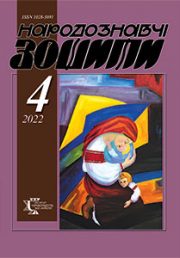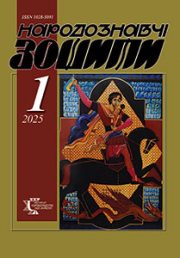The Ethnology Notebooks. 2020. № 4 (154), 854—866
UDK 738.011.26.02(=161.2)”199/202”(091)
DOI https://doi.org/10.15407/nz2020.04.854
POTTERY WARE OF THE UKRAINIANS OF 1990—2020: DIALOGUE OF TRADITIONS AND MODERNITY
MOTYL Romana
- ORCID ID: http://orcid.org/0000-0001-6936-0328
- Candidate of Arts (Ph. D), Associate Professor,
- Senior ResearcherFolk Art Department,
- Ethnology Institute of NAS of Ukraine,
- 15, Svobody ave., 79000, Lviv, Ukraine,
- Contacts: e-mail: romana_motyl@ukr.net
Abstract. The article highlights the phenomenon of Ukrainian pottery ware at the turn of the 20 — early 21 centuries — the most characteristic kind of ceramics, which has the deepest connections with the historical past. The given question seems rather topical, since in 1990—2020 there were significant changes in the manufacture of pottery — in addition to the disappearance of certain types of utensils, its functions have changed. The aim of the article is a comprehensive study of modern pottery ware of the Ukrainians from the objective standpoint of today.
The object of the study is pottery ware of the Ukrainians of 1990—2020, and the subject — the peculiarities of the development of pottery ware in the post-Soviet independent Ukraine and the patterns of formation and decoration of vessels.
The article is methodologically based on the principles of systematicity, historism and comparativism, applying cultural, historical as well as comparative and typological methods.
The scientific novelty of the article is to clarify the general features of the development of Ukrainian pottery ware in 1990—2020, analyze the evolution of folk pottery traditions and highlight innovative trends in pottery ware, identify new names of masters, study individual artifacts and introduce them into scientific circulation.
Results. In Ukrainian pottery ware, despite all the problems of the development of folk art at the present stage, there are still quite archaic elements. An example of the development of traditions in the late 1990s is the center in the village of Oleshniа, Chernihiv region аnd Slovyansk, Donetsk region. The change of local traditions due to the active filling with innovations is demonstrated by two large functioning centers — Kosiv, Ivano-Frankivsk region and Opishne, Poltava region. At the turn of the XX—XXI centuries we have the birth of the newest pottery centers (Chervonohrad, Lviv region). It was discovered that today, in spite of the background of the general economic crisis, the functions of folk ceramics are also changing: from purely utilitarian or decorative-applied to decorative. The article identifies the factors of activation of creative activity of potters in modern conditions (availability of material and technical base, exhibitions, plein airs, symposiums etc.), outlines ways to use the traditions of folk ceramics, highlights innovative trends in pottery ware in the 1990—2020.
The practical significance of the article consists in the possibility of using the main conclusions and theoretical principles in the process of subsequent research, materials discovered and involved in scientific circulation, their systematization and generalization will be useful for scientists who study the development of modern art.
Keywords: pottery ware, folk ceramics, traditions, innovation, potter, center, form, ornamental motifs.
Received 29.05.2020
REFERENSES
- Romanets, T.A. (1996). Ancient Origins of the Art of Ukrainian Ceramics. Kyiv: Prosvita [in Ukrainian].
- Spaska, Ye. (1995). Travels in the Chernihiv Region, Excerpts from Diaries of 1921—1926, Mainly about Chernihiv Pottery. Ukrainian Pottery: National Yearbook (Vol. 2, pp. 337—373). Opishne: Ukrainian Ethnography [in Ukrainian].
- Fride, M. (1928). Form and Ornament of Utensils from Podillya. Scientific Collection of the Leningrad Society of Researchers of Ukrainian History, Literature and Language. Kyiv [in Ukrainian].
- Shul’hina, L. (1929). Pottery in the Village. Bubnivka in Podillia. Materials for Ethnology (Issue 2). Kyiv [in Ukrainian].
- Matejko, K. I. (1959). Folk Ceramics of the Western Regions of the Ukrainian SSR of the 19—20 Centuries. Kyiv: Publishing of National Academy of Sciences [in Ukrainian].
- Klymenko, O. (1995). Folk Ceramics from Opishnia (To the Problem of Traditions and Innovations in Folk Arts and Crafts): avtoref. dys. kand. іn art. (17.00.06.). Lviv [in Ukrainian].
- Biliashivs’kyj, M. (1913). Something about Ukrainian Ornamentation, 3, 72—78 [in Ukrainian].
- Poshyvajlo, O. (2004). Pottery as an Indicator of Ethno-social Priorities. Ukrainian Ceramological Journal, 4, 7—14 [in Ukrainian].
- Motyl, R. (2011). Ukrainian Smoked Ceramics of the 19 — early 21 Centuries. History. Typology. Artistic Peculiarities. Lviv: The Instytut of Ethnology of National Academy of Sciences of Ukraine [in Ukrainian].
- Poshyvajlo, O. (Ed.). (2010). The First National Exhibition-Competition of Aristict Ceramics «Keram-PIK in Opishne!» (July 2 — October 30, 2009): Album-katalog. Opishne: Ukrainian Ethnography [in Ukrainian].
- Retriefed from: um.etnolog.org/ua/zmist/2011/4.pdf
- Miroshnychenko, O. (2005). The Current Situation in the Village of Oleshnya, Ripky District, Chernihiv Region. Ukrainian Ceramological Journal, 1—4, 177—178 [in Ukrainian].
- Denysenko, H. (2000). In the Name of Beauty. Folk Art, 1—2, 27 [in Ukrainian].
- Motyl, R. (2019). Pottery Center in Chervonograd — the Echo of the Past in the Modern Times. The Ethnology Notebooks, 1 (145), 66—72 [in Ukrainian].
- Poshyvajlo, O. (2002). Pottery Сenters of Ukraine: from the Zenith to the West. Ukrainian Ceramological Journal, 4, 3—8 [in Ukrainian].






